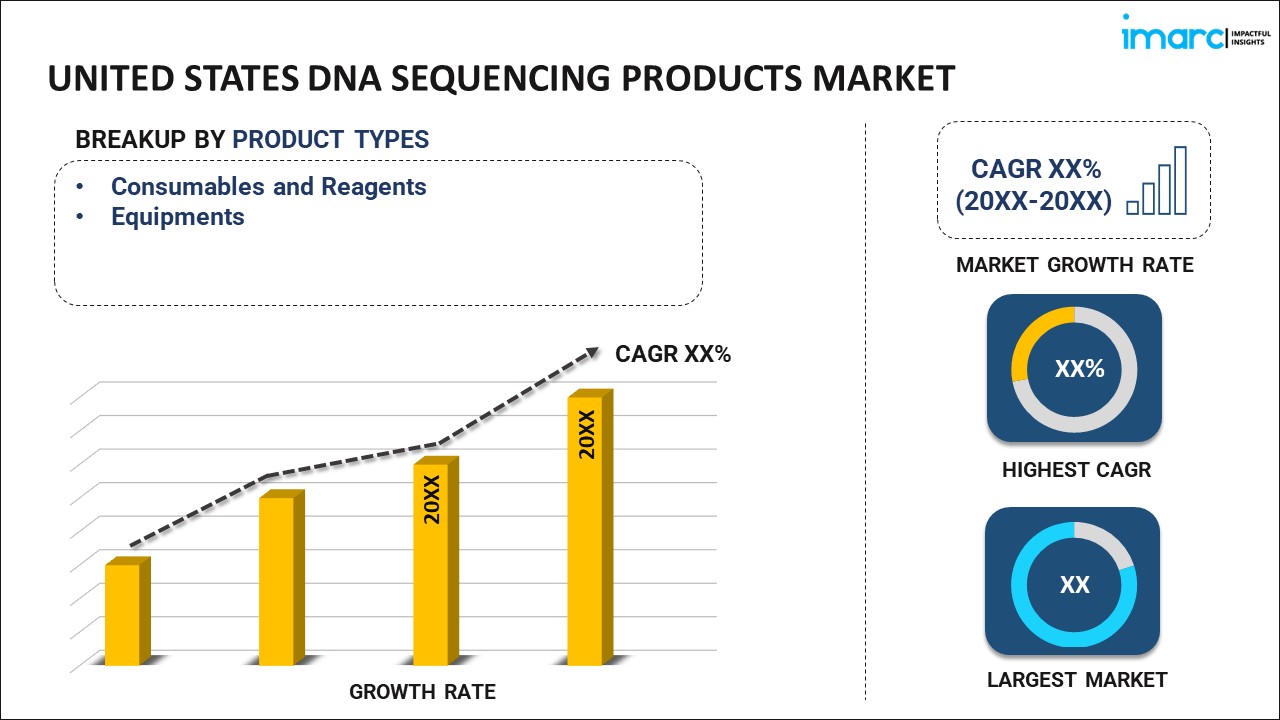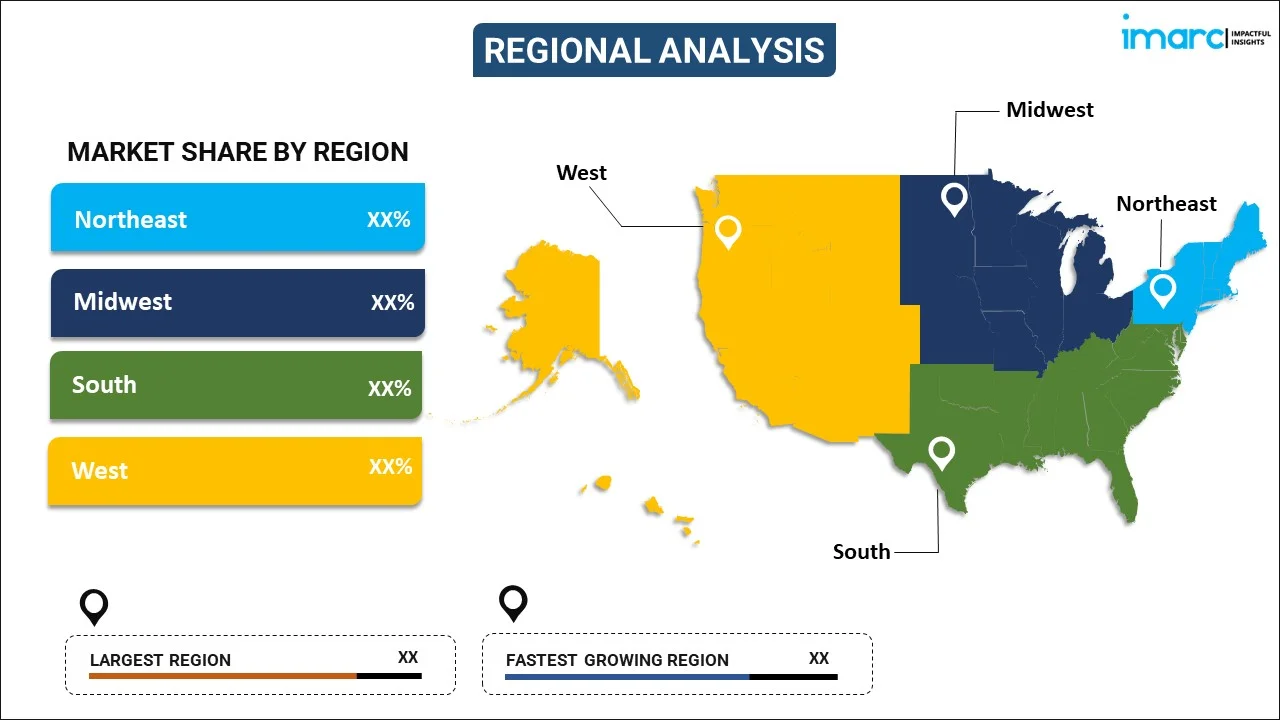
United States DNA Sequencing Products Market Report by Product Type (Consumables and Reagents, Equipments), Application (Biomarkers, Diagnostics, Reproductive Health, Forensics, Personalized Medicine, and Others), End User (Academic and Government Research Institutes, Pharmaceutical and Biotechnology Companies, Hospitals and Clinics, and Others), and Region 2025-2033
Market Overview:
The United States DNA sequencing products market size reached USD 3.5 Billion in 2024. Looking forward, IMARC Group expects the market to reach USD 11.1 Billion by 2033, exhibiting a growth rate (CAGR) of 13.02% during 2025-2033.
|
Report Attribute
|
Key Statistics
|
|---|---|
|
Base Year
|
2024
|
|
Forecast Years
|
2025-2033
|
|
Historical Years
|
2019-2024
|
| Market Size in 2024 | USD 3.5 Billion |
| Market Forecast in 2033 | USD 11.1 Billion |
| Market Growth Rate (2025-2033) | 13.02% |
DNA sequencing refers to a laboratory method that is utilized to ascertain the nucleotide sequence of the deoxyribonucleic acid (DNA). These nucleotides are the building blocks of nucleic acid, which include adenine (A), guanine (G), cytosine (C) and thymine (T). This method assists research professionals to gain insights into the genetic function or progression of living organisms to further determine the DNA linked disorders. DNA sequencing products are scientific instruments that are generally used to automate the sequencing process and enhance the metagenomic identification of closely related species to distinguish plasmid from the genome.
The market in the United States is primarily driven by significant growth in the field of bioinformatics. Along with this, numerous key players in the market are launching advanced data toolkits, a new suite of workflow functionality and data analysis tools, which will help researchers to detect and identify the SARS-CoV-2 viral sequence. Moreover, rapid advancements in sequencing products, such as the advent of sequencing by synthesis (SBS) and second-generation sequencing technologies, are creating a positive outlook for the market. Furthermore, rising investments by public and private firms to conduct extensive research and development (R&D) activities for introducing innovative DNA sequencing products with improved functions are contributing to the market growth across the country.
Key Market Segmentation:
IMARC Group provides an analysis of the key trends in each sub-segment of the United States DNA sequencing products market report, along with forecasts at the country and regional level from 2025-2033. Our report has categorized the market based on product type, application and end user.
Breakup by Product Type:

- Consumables and Reagents
- Equipments
Breakup by Application:
- Biomarkers
- Diagnostics
- Reproductive Health
- Forensics
- Personalized Medicine
- Others
Breakup by End User:
- Academic and Government Research Institutes
- Pharmaceutical and Biotechnology Companies
- Hospitals and Clinics
- Others
Breakup by Region:

- Northeast
- Midwest
- South
- West
Competitive Landscape:
The competitive landscape of the industry has also been examined along with the profiles of the key players.
Report Coverage:
| Report Features | Details |
|---|---|
| Base Year of the Analysis | 2024 |
| Historical Period | 2019-2024 |
| Forecast Period | 2025-2033 |
| Units | Billion USD |
| Segment Coverage | Product Type, Application, End User, Region |
| Region Covered | Northeast, Midwest, South, West |
| Customization Scope | 10% Free Customization |
| Post-Sale Analyst Support | 10-12 Weeks |
| Delivery Format | PDF and Excel through Email (We can also provide the editable version of the report in PPT/Word format on special request) |
Key Questions Answered in This Report:
- How has the United States DNA sequencing products market performed so far and how will it perform in the coming years?
- What has been the impact of COVID-19 on the United States DNA sequencing products market?
- What are the key regional markets?
- What is the breakup of the market based on the product type?
- What is the breakup of the market based on the application?
- What is the breakup of the market based on the end user?
- What are the various stages in the value chain of the industry?
- What are the key driving factors and challenges in the industry?
- What is the structure of the United States DNA sequencing products market and who are the key players?
- What is the degree of competition in the industry?
Need more help?
- Speak to our experienced analysts for insights on the current market scenarios.
- Include additional segments and countries to customize the report as per your requirement.
- Gain an unparalleled competitive advantage in your domain by understanding how to utilize the report and positively impacting your operations and revenue.
- For further assistance, please connect with our analysts.
 Inquire Before Buying
Inquire Before Buying
 Speak to an Analyst
Speak to an Analyst
 Request Brochure
Request Brochure
 Request Customization
Request Customization




.webp)




.webp)












